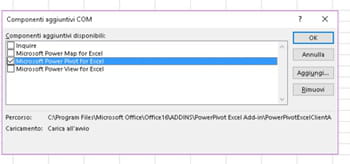Class Code
Powerpivot Excel 2016 Tutorial
Re: Power Pivot Excel 2019 Mac @Athira1512.However, the call for Microsoft to Add Power Pivot to Mac Excel is gaining more attention based on the Votes in the link below. More aboutPower Pivot. Troubleshooting: Power Pivot ribbon disappears. In rare cases, the Power Pivot ribbon will disappear from the menu if Excel determines that the add-in is destabilizing to Excel. This might occur if Excel closes unexpectedly while the Power Pivot window is open. To restore the Power Pivot menu, do the following. Fully agree that Power Pivot is a bery powerful tool, and looks like it is picking up quite nicely as the “brains” of the Microsoft Business Intelligence suite. Showing the Power Pivot tab in Excel Excel 2016 and 2013. From the left hand side, hit Options. The Excel Options dialog will open.
Power Pivot Excel Mac
Class Description
We can understand the importance of this feature and we suggest you add your vote and feedback to Add PowerPivot to Mac Excel as it helps to improve the product. In addition, Data Model option is also not available in Excel for Mac, but the feature is planned as stated in Excel UserVoice ( Add support for Get & Transform (formerly Power Query) ).
Effective immediately in response to COVID-19, all Technology Training classes will be delivered online until further notice.
In advance of each session, Tech Training will provide you with a Zoom link to your class, along with any required class materials.

Discover the new powerful relational-database functionality hidden inside Excel and learn how to quickly build extremely flexible and beautiful reports with Power Pivot, an ideal tool for when your data is not all in one place.
Note: This functionality is not available in Excel for Mac. It is exclusive to MS Office on Windows.
Power Pivot is an analysis-and-reporting tool, which provides ultimate flexibility when preparing powerful, actionable, dynamic reports from your data. Even if your data comes from multiple sources.
Power Pivot contains a data modeling tool that gives you full-blown relational-database capabilities right in Excel - which had never been possible before.
If you work with datasets and must prepare reports in Excel and still yet to learn how to tap into the incredible power of Power Pivot, you are truly missing out.
In this class you will get a quick but solid introduction to Excel Power Pivot and become more comfortable handling data and preparing visual reports inside Excel.
Here’s a sample of what you’ll learn in class:

- The incredible benefits of Power Pivot to your vs. 'Snowflakes' and what they have to do with data modeling.
- Several ways to add data to a data model before you build your reports.
- How to build, clean, and perfect data models - to make them as user-friendly as humanly possible.
- The important differences between traditional pivot tables and those you create from Excel data model. Plus pros and cons of each.
- Working with huge datasets: how to create a pivot table report if your data does not even fit inside Excel. (For example from a dataset of more than one hundred million records.)
- Boost flexibility (and usefulness) of your reports with powerful calculations using DAX - short for Data Analysis eXpressions - the formulas of Power Pivot.
- Time intelligence - slice and present your data from the calendar perspective. How to show running-total, year-to-date, month-to-date, fiscal-year and other time dimensions.
- Tips to redesign your data-management and data-reporting workflow for maximum efficiency and speed.
You should attend this class if:
- You want to discover more robust techniques to work with data than you use right now. (Especially if you get data from multiple data sources.)
- You want to learn how to use relational-database features inside Excel to connect separate data sources with maximum efficiency.
- You want to learn how to create beautiful, visually-appealing, refreshable reports based on Excel Data Models.
- You are already familiar with regular pivot tables and realize that you can do even better.
Prerequisites: Ideally, you should take this class if you are already familiar with regular pivot tables

University IT Technology Training classes are only available to Stanford University staff, faculty, or students. A valid SUNet ID is needed in order to enroll in a class.
Over the years, knowing whether you have access to the Power Pivot feature in Excel has been challenging at times to say the least. First introduced as an add-in for Excel 2010, availability of the tool has varied, depending upon which version of Excel you utilized. Fortunately, Microsoft simplified access to Power Pivot with the release of Excel 2019 and now, more people than ever have access to the feature.which versions of Office/Excel provide access to power Pivot?
As of January 8, 2019, you have access to Power Pivot if you are running any of the following versions of Microsoft Office/Excel.
- An Office 365 subscription that includes a Desktop license of Excel for Windows
- Office Professional 2019
- Office Home & Business 2019
- Office Home & Student 2019
- Office 2016 Professional Plus
- Office 2013 Professional Plus
- Excel 2013 and Excel 2016 when purchased as a standalone product
Additionally, if you are still running Excel 2010, you can download the add-in for that version of Excel by clicking here or navigating to https://www.microsoft.com/en-us/download/details.aspx?id=43348. Note, however, that version of the add-in will work only with Excel 2010.

which versions of office/excel do not provide access to power Pivot?
Power Pivot is not available to those running any of the following versions of Microsoft Office/Excel.
- An Office 365 subscription that does NOT provide a desktop license of Excel for Windows
- Any version of Office for Mac
- Office Professional 2013
- Office Professional 2016
- Office Home & Student 2013
- Office Home & Student 2016
- Office Home & Business 2013
- Office Home & Business 2016
- Office for Android
- Office RT 2013
- Office Standard 2013
- Office Standard 2016
- All Office versions older than 2013, unless you download the add-in for Excel 2010
Power Pivot Use Cases
Regardless of the version of Excel you might use to access Power Pivot, the principal use case of this feature remains the same – it is used to manage data models in Excel. In addition, you can use Power Pivot to create links to external data sources and use the data provided by those data sources to populate your data models, although many will find Power Query to be a better option for this application. Of course, once you create a data model, you can then summarize and analyze the data in the data model rather easily using PivotTables and, when necessary, CUBE functions in Excel.
You can learn more about this valuable Excel feature from Microsoft by clicking here.
Share on facebookFacebook Share on twitterTwitter Share on linkedinLinkedIncheck out these power pivot learning options from k2 enterprises
